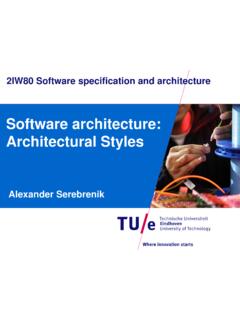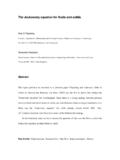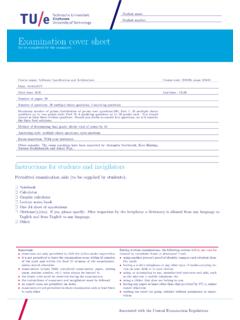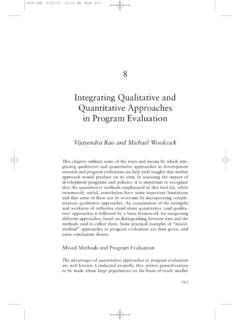Transcription of Scenario-Based Software Architecture Evaluation Methods ...
1 1 Abstract Software analysis and Evaluation becomes a well-established practice inside the architecting community of the Software systems. The development effort, the time and costs of complex systems are considerably high. In order to assess system s quality against the requirements of its customers, the architects and the developers need Methods and tools to support them during the Evaluation process. Different research groups have taken such initiatives and are proposing various Methods for Software Architecture quality Evaluation .
2 1. INTRODUCTION Recently, a number of new Scenario-Based Software Architecture Evaluation Methods have been developed by different academic groups and published in form of books or doctoral dissertation theses. Many of these Methods are refinements of SAAM or ATAM, an initiative of Carnegie Mellon Institute. They usually restrict themselves to a particular class of systems and to a limited set of ilities . For example, the ALMA method described in this paper focuses on the modifiability of Business Information Systems.
3 Another newly developed approach , the FAAM, assesses the interoperability and extensibility of information-system families. Even though the latest Methods were always using the previous defined ones, there was not been yet much effort done towards an Evaluation of their relative merits. The international working group on Software Architecture Review and Assessment (SARA) has taken the initiative of publishing a review with all existing Evaluation Methods . This paper is intended as a contribution to this review. The analysis is performed in accordance with the requirements specified in the SARA report [8].
4 Mugurel T. Ionita Student of Technical University Eindhoven Below there is given the set of Methods currently available and supporting the analysis of Software Architecture quality attributes: 1. SAAM, Software Architecture Analysis Method, [1],[3] 2. ATAM, Architecture Trade-off Analysis Method, [1],[2] 3. CBAM, Cost Benefit Analysis Method, [1],[4] 4. ALMA, Architecture Level Modifiability Analysis [5], [6] 5. FAAM, Family Architecture Analysis Method [7] The content of the analysis is organized in the following manner: firstly, the description of each method is given; secondly, an overview including all different Methods together with a comparison between them is given.
5 2. OVERVIEW Software Architecture Analysis Method (SAAM) SAAM Context SAAM is the first widely promulgated Scenario-Based Software Architecture analysis method. It was created [3] to assess the architectures modifiability in its various names. SAAM Purpose SAAM creators looked for a method able to express the different quality claims of Software architectures (such as modifiability, flexibility, maintainability, etc.) by means of scenarios and to evaluate them against the actuals. In practice SAAM has proven useful for quickly assessing many quality attributes such as modifiability, portability, extensibility, integrability, as well as functional coverage.
6 The method can also be used to assess quality aspects of Software architectures such as performance or reliability. However, ATAM is treating these aspects in more detail (see page 3), being an improved version of SAAM. If a single Architecture is analyzed, SAAM indicates the weak or strong points, together with the points of where the Architecture fails to meet its modifiability requirements. Scenario-Based Software Architecture Evaluation Methods : An Overview Mugurel T. Ionita1, Dieter K. Hammer1, Henk Obbink22 Department Software Architectures, Philips Research, Prof.
7 Holstlaan 4, 5656 AA Eindhoven, The Netherlands, 1 Department of Mathematics and Computing Science, Technical University Eindhoven, Box 513, Den Dolech 2, 5600 MB, Eindhoven, The Netherlands, 2If two or more different candidate architectures, providing the same functionality, are compared with respect to their modifiability SAAM can produce a relative ranking between them. Key Factors in SAAM Development The development of SAAM was motivated by a variety of opinions about Software architectures and the lack of Methods and common basis to address them.
8 The designers and the architects of Software systems were not able to reason about the quality of their developed Software , or still under development. Consequently, common quality attributes like modifiability, flexibility or maintainability, were not associated with direct Software artifacts that can be analyzed and measured. Prerequisites and Inputs of SAAM System quality attributes that are going to be evaluated in a SAAM session must be addressed in a certain context. This imposed the adoption of scenarios as the descriptive means in specifying and evaluating qualities.
9 Besides scenarios , there must be available for all participants the system Architecture description, the reference artifact, which the quality scenarios are mapped onto. A number of scenarios , describing the interaction of a user with the system, are the primary inputs to a SAAM Evaluation session. Steps in a SAAM Evaluation Session The method consists of six main steps, which typically are preceded by a short overview of the general business context and required functionality of the system. SAAM Step 1 Develop scenarios The first step in a SAAM session is a brainstorm exercise with the scope of identifying the type of activities that the system must support.
10 These activities together with possible modifications that the stakeholders can anticipate are grouped in so called system scenarios . In developing scenarios the challenge is to capture all major uses and users of the system, all quality attributes and their associated level that the system must reach and most important all foreseeable future changes to the system. This exercise is usually performed two times. The more iterations and architectural information is shared the more scenarios are surfaced by the participants. Thus the Architecture description and scenario development influence each other.




![cTRW]XbRWTd]XeTabXcTXcTX]SW^eT] Assignment 2 …](/cache/preview/d/5/c/4/6/f/6/0/thumb-d5c46f603d1ae108feb7b9bdb9fecab3.jpg)














